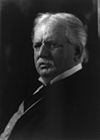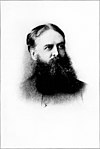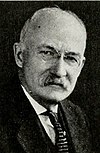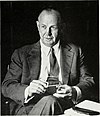AT&T Corporation
 The logo AT&T currently uses, launched in 2016. | |
| Formerly | American Telephone and Telegraph Company |
|---|---|
| Type | Subsidiary |
| Industry | Telecommunications |
| Founded | March 3, 1885 New York City, United States |
| Founders | Alexander Graham Bell Gardiner Greene Hubbard[1] Thomas Sanders[2] |
| Headquarters | Dallas, Texas , United States |
Area served | United States |
| Products |
|
| Parent | American Bell (1885–1899) Bell System (1899–1984) Independent (1984–2005) AT&T Inc. (2005–present) |
| Subsidiaries | AT&T Communications Inc. |
| Website | www |
AT&T Corporation, originally the American Telephone and Telegraph Company, is the subsidiary of AT&T Inc. that provides voice, video, data, and Internet telecommunications and professional services to businesses, consumers, and government agencies.
During its long history, AT&T was at times the world's largest telephone company, the world's largest cable television operator, and a regulated monopoly. At its peak in the 1950s and 1960s, it employed one million people and its revenue ranged between US$3 billion in 1950[3] ($35.1 billion in present-day terms[4]) and $12 billion in 1966[5] ($99.1 billion in present-day terms[4]).
In 2005, AT&T was purchased by Baby Bell and former subsidiary SBC Communications for more than $16 billion ($21.2 billion in present-day terms[4]). SBC then changed its name to AT&T Inc.
History[]
Origins[]


AT&T started with Bell Patent Association, a legal entity established in 1874 to protect the patent rights of Alexander Graham Bell after he invented the telephone system. Originally a verbal agreement, it was formalized in writing in 1875 as Bell Telephone Company.[6][7]
In 1880 the management of American Bell had created what would become AT&T Long Lines. The project was the first of its kind to create a nationwide long-distance network with a commercially viable cost-structure. The project was formally incorporated in New York as a separate company named American Telephone and Telegraph Company on March 3, 1885. Originating in New York City, its long-distance telephone network reached Chicago, Illinois, in 1892,[8] with its multitudes of local exchanges continuing to stretch further and further yearly, eventually creating a continent-wide telephone system. On December 30, 1899, the assets of American Bell were transferred into its subsidiary American Telephone and Telegraph Company (formerly AT&T Long Lines); this was because Massachusetts corporate laws were very restrictive, and limited capitalization to ten million dollars, forestalling American Bell's further growth. With this assets transfer at the very end of the 19th century, AT&T became the parent of both American Bell and the Bell System.[9]
AT&T was involved mainly in the telephone business and, although it was a partner with RCA, was reluctant to see radio grow because such growth might diminish the demand for wired services. It established station WEAF in New York as what was termed a toll station. AT&T could provide no programming, but anyone who wished to broadcast a message could pay a "toll" to AT&T and then air the message publicly. The original studio was the size of a telephone booth. The idea, however, did not take hold, because people would pay to broadcast messages only if they were sure that someone was listening. As a result, WEAF began broadcasting entertainment material, drawing amateur talent found among its employees. Opposition to AT&T's expansion into radio and an agreement with the National Broadcasting Company to lease long-distance lines for their broadcasts resulted in the sale of the station and its developing network of affiliates to NBC.[10]
Monopoly[]
Throughout most of the 20th century, AT&T held a monopoly on phone service in the United States and Canada through a network of companies called the Bell System. At this time, the company was nicknamed Ma Bell.
On April 30, 1907, Theodore Newton Vail became President of AT&T.[11][12] Vail believed in the superiority of one phone system and AT&T adopted the slogan "One Policy, One System, Universal Service."[11][12] This would be the company's philosophy for the next 70 years.[12]
Under Vail, AT&T began buying up many of the smaller telephone companies including Western Union telegraph.[11][12] These actions brought unwanted attention from antitrust regulators. Anxious to avoid action from government antitrust suits, AT&T and the federal government entered into an agreement known as the Kingsbury Commitment.[11][12] In the Kingsbury Commitment, AT&T and the government reached an agreement that allowed AT&T to continue operating as a monopoly. While AT&T periodically faced scrutiny from regulators, this state of affairs continued until the company's breakup in 1984.
The Break-up[]
This section needs additional citations for verification. (February 2021) |
The United States Justice Department opened the case United States v. AT&T in 1974. This was prompted by suspicion that AT&T was using monopoly profits from its Western Electric subsidiary to subsidize the cost of its network, a violation of antitrust law.[13] A settlement to this case was finalized in 1982, leading to the division of the company on January 1, 1984, into seven Regional Bell Operating Companies, commonly known as Baby Bells. These companies were:
- Ameritech, acquired by SBC in 1999, now part of AT&T Inc.
- Bell Atlantic (now Verizon Communications), which acquired GTE in 2000
- BellSouth, acquired by AT&T Inc. in 2006
- NYNEX, acquired by Bell Atlantic in 1996, now part of Verizon Communications
- Pacific Telesis, acquired by SBC in 1997, now part of AT&T Inc.
- Southwestern Bell (later SBC, now AT&T Inc.), which acquired AT&T Corp. in 2005
- US West, acquired by Qwest in 2000, which in turn was acquired by CenturyLink in 2011
Post-breakup, the former parent company's main business was now AT&T Communications Inc., which focused on long-distance services, and with other non-RBOC activities.
AT&T acquired NCR Corporation in 1991. AT&T announced in 1995 that it would split into three companies: a manufacturing/R&D company, a computer company, and a services company. NCR, Bell Labs and AT&T Technologies were to be spun off by 1997. In preparation for its spin-off, AT&T Technologies was renamed Lucent Technologies. Lucent was completely spun off from AT&T in 1996.
Acquisition by SBC[]
On January 31, 2005, the "Baby Bell" company SBC Communications announced its plans to acquire "Ma Bell" AT&T Corp. for $16 billion. SBC announced in October 2005 that it would shed the "SBC" brand and take the AT&T brand along with the "T" NYSE ticker symbol.
Merger approval concluded on November 18, 2005; SBC Communications began rebranding the following Monday, November 21 as "AT&T Inc." and began trading as AT&T on December 1 under the "T" symbol.
The AT&T headquarters buildings[]
From 1885 to 1910, AT&T was headquartered at 125 Milk Street in Boston. With its expansion it moved to New York City, to a headquarters on 195 Broadway (close to what is now the World Trade Center site). The property originally belonged to Western Union, of which AT&T held a controlling interest until 1913 when AT&T divested its interest as part of the Kingsbury Commitment.[12] Construction of the current building began in 1912. Designed by William Welles Bosworth, who played a significant role in designing Kykuit, the Rockefeller mansion north of Tarrytown, New York, it was a modern steel structure clad top to bottom in a Greek-styled exterior, the three-story-high Ionic columns of Vermont granite forming eight registers over a Doric base.[14] The lobby of the AT&T Building was one of the most unusual ones of the era. Instead of a large double-high space, similar to the nearby Woolworth Building, Bosworth designed what is called a "hypostyle hall", with full-bodied Doric columns modeled on the Parthenon, marking out a grid. Bosworth was seeking to coordinate the classical tradition with the requirements of a modern building. Columns were not merely the decorative elements they had become in the hands of other architects but created all the illusion of being real supports. Bosworth also designed the campus of MIT as well as Theodore N. Vail's mansion in Morristown, New Jersey.
In 1978, AT&T commissioned a new building at 550 Madison Avenue. This new AT&T Building was designed by Philip Johnson and quickly became an icon of the new Postmodern architectural style. The building was completed in 1984, the very year of the divestiture of the Bell System. The building proved to be too large for the post-divestiture corporation and in 1993, AT&T leased the building to Sony, which now owns it.[15][16]
Divisions[]
AT&T, prior to its merger with SBC Communications, had three core companies:
AT&T Alascom continues to sell service in Alaska. AT&T Communications was renamed AT&T Communications – East, Inc. and sold long-distance telephone service and operated as a CLEC outside of the borders of the Bell Operating Companies that AT&T owns. It has now been absorbed into AT&T Corp. and all but 4 of the original 22 subsidiaries that formed AT&T Communications continue to exist. The AT&T company had become too large and the government, having water to prevent a monopoly forced AT&T to break up. AT&T Laboratories has been integrated into AT&T Labs, formerly named SBC Laboratories.
Nicknames and branding[]
AT&T was also known as "Ma Bell" and affectionately called "Mother" by phone phreaks. During some strikes by its employees, picketers would wear T-shirts reading, "Ma Bell is a real mother." It is worth noting too that, before the break-up, there was greater consumer recognition of the "Bell System" name, in comparison to the name AT&T. This prompted the company to launch an advertising campaign after the break-up to increase its name recognition. Spinoffs like the Regional Bell Operating Companies or RBOCs were often called "Baby Bells". Ironically, "Ma Bell" was acquired by one of its "Baby Bells", SBC Communications, in 2005.
The AT&T Globe Symbol,[17] the corporate logo designed by Saul Bass in 1983 and originally used by AT&T Information Systems, was created because part of the United States v. AT&T settlement required AT&T to relinquish all claims to the use of Bell System trademarks. It has been nicknamed the "Death Star" in reference to the Death Star space station in Star Wars which the logo resembles. In 1999 it was changed from the 12-line design to the 8-line design. Again in 2005 it was changed to the 3D transparent "marble" design created by Interbrand for use by the parent company AT&T Inc. This name was also given to the iconic Bell Labs facility in Holmdel, New Jersey, now a multi-tenant office facility.[citation needed]
List of AT&T chief executive officers[]
The following is a list of the 16 CEOs of AT&T Corporation, from its incorporation in 1885 until its purchase by SBC Communications in 2005.[18]
| # | chief executive officer | Years in office | Title |
|---|---|---|---|
| 1 |  Theodore Newton Vail Theodore Newton Vail
|
1885–1887 | President |
| 2 |  John E. Hudson John E. Hudson
|
1887–1900 | President |
| 3 | Frederick Perry Fish | 1901–1907 | President |
| 4 |  Theodore Newton Vail Theodore Newton Vail
|
1907–1919 | President |
| 5 |  Harry Bates Thayer Harry Bates Thayer
|
1919–1925 | President |
| 6 |  Walter Sherman Gifford Walter Sherman Gifford
|
1925–1948 | President |
| 7 | Leroy A. Wilson | 1948–1951 | President |
| 8 |  Cleo F. Craig Cleo F. Craig
|
1951–1956 | President |
| 9 | Frederick Kappel | 1956–1961 1961–1967 |
President Chairman |
| 10 | H.I. Romnes | 1967–1972 | Chairman |
| 11 | John D. deButts | 1972–1979 | Chairman |
| 12 | Charles L. Brown | 1979–1986 | Chairman |
| 13 | James E. Olson | 1986–1988 | Chairman |
| 14 | Robert Eugene Allen | 1988–1997 | Chairman |
| 15 | C. Michael Armstrong | 1997–2002 | Chairman |
| 16 | David Dorman | 2002–2005 | Chairman |
See also[]
- Bell Telephone Memorial, a monument sculpted by W.S. Allard, commemorating the invention of the telephone
- International Bell Telephone Company, sister company to American Bell Telephone, with its headquarters in Brussels, Belgium
References[]
Citations[]
- ^ name=robertbrucebook>Bruce, Robert V. (1990) [1st pub. 1973]. Bell: Alexander Graham Bell and the Conquest of Solitude. Ithaca, NY: Cornell University Press. p. 231. ISBN 0-8014-9691-8.
- ^ Bruce, Robert V. (1990) [1st pub. 1973]. Bell: Alexander Graham Bell and the Conquest of Solitude. Ithaca, NY: Cornell University Press. p. 231. ISBN 0-8014-9691-8.
- ^ "Annual Report 1950, American Telephone & Telegraph Company" (PDF). Archived (PDF) from the original on January 6, 2021. Retrieved August 7, 2020.
- ^ Jump up to: a b c 1634 to 1699: McCusker, J. J. (1992). How Much Is That in Real Money? A Historical Price Index for Use as a Deflator of Money Values in the Economy ofthe United States: Addenda et Corrigenda (PDF). American Antiquarian Society. 1700-1799: McCusker, J. J. (1992). How much is that in real money?: a historical price index for use as a deflator of money values in the economy of the United States (PDF). American Antiquarian Society. 1800–present: Federal Reserve Bank of Minneapolis. "Consumer Price Index (estimate) 1800–". Retrieved January 1, 2020.
- ^ "Annual Report 1966, American Telephone & Telegraph Company" (PDF). Archived (PDF) from the original on January 6, 2021. Retrieved August 7, 2020.
- ^ Bruce 1990, p. 291.[full citation needed]
- ^ Pizer 2009, pp. 120–124.Bruce 1990, p. 291[full citation needed]
- ^ Bruce 1990.Bruce 1990, p. 291[full citation needed]
- ^ Brooks 1976, p. 107.Bruce 1990, p. 291[full citation needed]
- ^ Perry, S. D. (2004). A Consolidated History of Media (3rd ed.). Bloomington, IL: Epistelogic.[page needed]
- ^ Jump up to: a b c d Thierer, Adam D. (1994). "Unnatural Monopoly: Critical Moments in the Development of the Bell System Monopoly" (PDF). Cato Journal. Cato Institute. 14 (2): 267–285. Archived (PDF) from the original on April 27, 2019. Retrieved May 15, 2019.
- ^ Jump up to: a b c d e f "AT&T Milestones in AT&T History". AT&T. Archived from the original on September 28, 2008. Retrieved September 17, 2008.
- ^ Yurick, p. 7.Bruce 1990, p. 291[full citation needed]
- ^ Jarzombek, Mark (2004). Designing MIT: Bosworth's New Tech. Boston: Northeastern University Press. pp. 65–68. ISBN 1555536190. OCLC 55124376.
- ^ Popik, Barry (September 25, 2005). "Chippendale Building (SONY building)". The Big Apple. Archived from the original on January 12, 2019. Retrieved December 6, 2006.
- ^ Stoler, Michael (September 8, 2005). "Fortune 100 Companies Capitalize on Record Prices". The Stoler Report. First American Title Insurance Company of New York. Archived from the original on December 26, 2007.
- ^ Massey, David. "Bell Logo History". Bell System Memorial. The Porticus Centre. Archived from the original on September 30, 2011.
- ^ Focus magazine (internal AT&T company publication), sidebar titled "AT&T's chief executives", 1988
Sources[]
- Works cited
- Brock, Gerald W. (1981). The Telecommunications Industry The Dynamics Of Market Structure. Harvard Economic Studies. Cambridge, MA: Harvard University Press. ISBN 978-0-674-87285-1.
- Brooks, John (1976). Telephone The First Hundred Years. Harper & Row. ISBN 978-0-06-010540-2.
- "Milestones in AT&T History". AT&T. Retrieved December 14, 2013.
External links[]
- AT&T (Archive)
- The short film A CONTINENT IS BRIDGED (Reel 1 of 4, Reel 2 of 4, Reel 3 of 4, Reel 4 of 4) (1940) is available for free download at the Internet Archive
- American Telephone & Telegraph logos, adverts and historical telephone maps on the Baring archive Risks and Rewards website
- Historical AT&T Financial Documents
- AT&T
- Bell System
- Telecommunications companies established in 1885
- Telecommunications monopolies
- Companies based in Somerset County, New Jersey